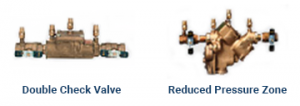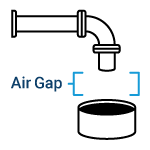Backflow is the backward movement of normal water flow. This can result from a drop in the customer’s water pressure or from suction in the water supply caused by a break in the water distribution piping. This can cause contaminants to drain back into the drinking water supply.

 A Double Check Valve backflow assembly is installed for low hazard (non-toxic) conditions. A Reduced Pressure Zone backflow assembly is installed for high hazard (toxic) conditions.
A Double Check Valve backflow assembly is installed for low hazard (non-toxic) conditions. A Reduced Pressure Zone backflow assembly is installed for high hazard (toxic) conditions. An air gap is a vertical, physical separation between the end of a water supply outlet and the flood-level rim of a receiving vessel. This separation must be at least twice the diameter of the water supply outlet and never less than one inch. An air gap is considered the maximum protection available against backpressure backflow or backsiphonage but is not always practical and can easily be bypassed.
An air gap is a vertical, physical separation between the end of a water supply outlet and the flood-level rim of a receiving vessel. This separation must be at least twice the diameter of the water supply outlet and never less than one inch. An air gap is considered the maximum protection available against backpressure backflow or backsiphonage but is not always practical and can easily be bypassed.